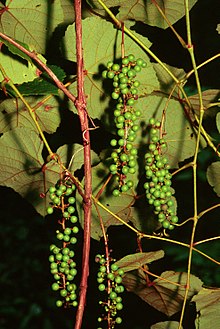bio.wikisort.org - Plant
Vitis aestivalis, the summer grape,[1] or pigeon grape[2] is a species of grape native to eastern North America from southern Ontario east to Maine, west to Oklahoma, and south to Florida and Texas.[3][4] It is a vigorous vine, growing to 10 m or more high in trees. The leaves are 7–20 cm long, suborbicular, and usually a little broader than long; they are variable in shape, from unlobed to deeply three- or five-lobed, green above, and densely hairy below. The flowers are produced at every 3rd node[2] in a dense panicle 5–15 cm long. The fruit is a small grape 5–14 mm diameter, dark purple or black in colour.[5] It is the official state grape of Missouri.[6] Summer grape prefers a drier upland habitat.[2]
The four varieties are:[3]
- V. a. var. aestivalis
- V. a. var. bicolor Deam (syn. var. argentifolia Fernald; Silverleaf Grape), formerly called Vitis bicolor, but now considered a northern variation of Vitis aestivalis, native range is in the Northeastern United States and parts of Southern Ontario
- V. a. var. lincecumii (Buckley) Munson
- V. a. var. bourquiniana L.H. Bailey, native to the south, sometimes called Vitis bourquiniana, has tomentose undersides to the leaves
Cultivation and uses

Several cultivars have been selected, including 'Norton', a cultivar with a substantial V. aestivalis background, is believed to be the oldest American grape cultivar in commercial production.
Inter specific-hybrids made with the species V. aestivalis, such as Norton, have shown several useful traits for commercial wine production when compared with other North American native grape varieties. These traits include: lower acidity, neutral, "vinifera-like" flavour profile, good tannin structure, and excellent disease resistance.
Unlike most other species in genus Vitis, V. aestivalis does not propagate well through dormant cuttings. This has been a limiting factor for its use in commercial viticulture despite the species's promising oenological characteristics. Propagation of V. aestivalis specimens must typically be made through layering or through green cuttings. The species typically does not tolerate highly calcareous soils.[7]
It has been claimed that a variety of V. aestivalis was cultivated by the Cherokees and used in some of their sacred rituals.[8]
Gallery
- Vitis aestivalis
See also
- American wine
- Missouri wine
- New York wine
References
- USDA, NRCS (n.d.). "Vitis aestivalis". The PLANTS Database (plants.usda.gov). Greensboro, North Carolina: National Plant Data Team. Retrieved 6 August 2015.
- Rhoads, Block (5 September 2007). The Plants of Pennsylvania (2 ed.). ISBN 978-0-8122-4003-0.
- "Vitis aestivalis". Germplasm Resources Information Network (GRIN). Agricultural Research Service (ARS), United States Department of Agriculture (USDA). Retrieved 15 December 2017.
- Biota of North America Program 2014 county distribution map
- Oklahoma University: Vitis aestivalis
- http://www.moga.mo.gov/statutes/chapters/chap010.htm [dead link]
- Appellation America: Norton / Cynthiana
- Mooney, James (1992). History, Myths, and Sacred Formulas of the Cherokees. Historical Images. ISBN 0-914875-19-1.
External links
- Flora of North America: Vitis aestivalis
- Plants of the World Online: Vitis aestivalis
- Vitis aestivalis 'Norton', from a Missouri Botanical Gardens website
- Official state grape of Missouri, from a Missouri General Assembly website
На других языках
- [en] Vitis aestivalis
[es] Vitis aestivalis
Vitis aestivalis es una especie de vid autóctona del este de América del Norte en la zona comprendida desde el sur de Ontario al este de Vermont, al oeste de Oklahoma, y el sur de Florida y Texas.[1]Другой контент может иметь иную лицензию. Перед использованием материалов сайта WikiSort.org внимательно изучите правила лицензирования конкретных элементов наполнения сайта.
WikiSort.org - проект по пересортировке и дополнению контента Википедии



